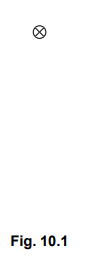Question
Fig. 9.1 shows a simple electric motor with a single rectangular coil between magnetic poles X and Y.

(a) (i) Add labels to the empty boxes to the right of Fig. 9.1, to identify the parts indicated.
(ii) The coil rotates in a clockwise direction when viewed from point P.
State which of the magnetic poles, X or Y, is the N-pole.
(b) (i) Suggest two changes that cause the motor to spin faster.
1. ………………………………………………………………………………………………………………………
2. ………………………………………………………………………………………………………………………
(ii) State the effect on the motor of reversing the connections to the battery.
(c) The battery in Fig. 9.1 is replaced with a resistor. The coil is made to rotate by an external mechanism.
Explain why there is a current in the resistor.
Answer/Explanation
Answer:
(a) (i) Upper box: (split-ring) commutator OR split-ring
Lower box: brush(es) OR contact(s)
(ii) X (is the N pole)
Greater current (through coil) OR battery with greater voltage
More turns coil OR coil with greater area
Use stronger magnet OR soft-iron core in coil OR bring magnetic
poles closer to coil
(ii) Coil rotates in opposite direction
OR rotates anticlockwise
OR rotation reversed
(c) Magnetic field is cut (by the wires of the coil)
Electromagnetic induction takes place
OR Voltage/e.m.f. is induced/produced (causing in the coil)
OR Current is induced (in the coil)
Question
(a) Fig. 10.1 shows the cross-section of a wire carrying a current into the plane of the paper.

On Fig. 10.1, sketch the magnetic field due to the current in the wire. The detail of your sketch should suggest the variation in the strength of the field. Show the direction of the field with arrows.
(b) Fig. 10.2 shows part of a model of a d.c. motor.

(i) On Fig. 10.2, draw arrows to show the directions of the forces acting on side AB
and on side CD of the loop.
(ii) With the loop in the position shown in Fig. 10.2, explain why the forces on AB and
CD cause the loop to rotate about the axis.
(iii) The ends X and Y of the loop are connected to a battery using brushes and a splitring commutator.
State why a split-ring commutator is used.
Answer/Explanation
Answer:
(a) at least 3 concentric circles centred on wire B1 arrows clockwise on each circle / at least one circle spacing of circles increasing as radius increases
(b) (i) arrow pointing down on side AB, up on side CD
(ii) forces on AB and CD are opposite OR up and down and separated / not in same line (so cause rotation) OR have moments in same sense / direction OR cause couple / torque
(iii) to reverse current in loop or keep current in AB or CD in the same direction OR keep current on side near a pole in the same direction when (plane of) coil is vertical OR every half turn OR when AB and CD swap sides so that: rotation continues (in same direction) OR so that rotation doesn’t reverse its direction OR to maintain sense/direction of moments/couple OR coil turns more than half a revolution
